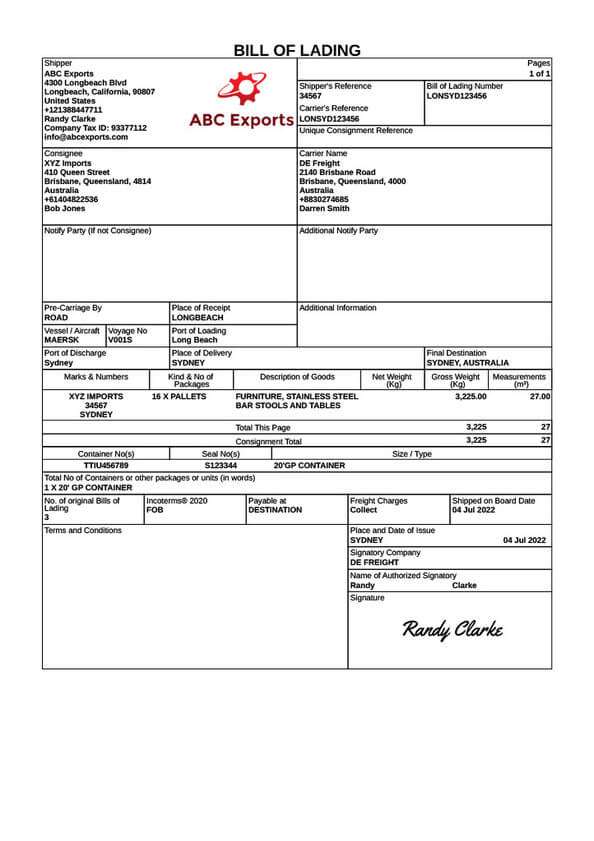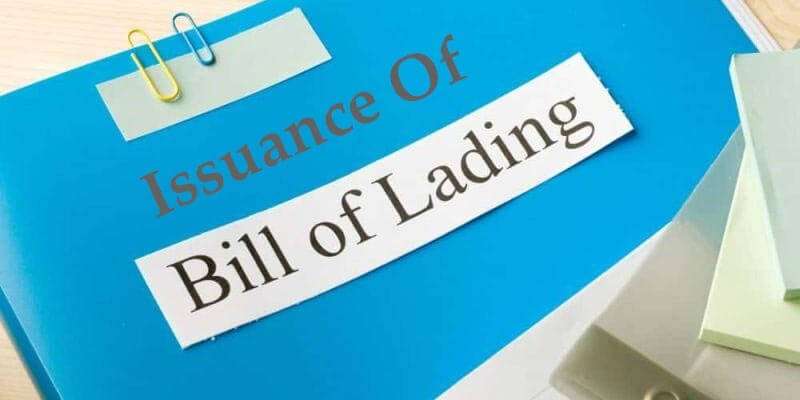Abbreviation : bill of lading – BL, BoL, B/L

B/L, BoL, BL
This article talks about complete details on bill of lading and its importance in export- import operations.
Every international consignment involves three parties:
1. consignor (exporter)
2. consignee(importer)
3. carrier (shipping or transportation company)
when an international consignment is agreed between an exporter and importer, a third party which is the shipping or transportation company known as carrier, issues and signs a document called bill of Lading. The Bill of lading is issued by the carrier to the exporter, once the cargo is loaded onboard of a shipping vessel.
Bill of lading – definition
BoL is a document of contract of carriage between the exporter and the shipping agent or the shipping company, which clearly states that the goods have been received on board and is a legal document as it confirms the ownership of the goods being exported.
Purpose of bill of lading
The purpose of bill of lading is to ensure that the exporter receives the payment and the importer receives the goods on time.
FAQs?
why is it called bill of “lading” ?
The word “lading” means “loading”, both words being derived from the Old English word ladan. “Lading” specifically refers to the loading of cargo aboard a ship.
who is a consignor in BoL document?
A consignor is a seller or exporter and is often referred to as the shipper. Consignor can be an individual or business that initiates and organizes the process of shipping their goods.
who is the shipper on BoL document?
The exporter is the Shipper in the BoL document, the exporter ships the goods from port of origin through the shipping vessel to port of destination.
who issues the bill of lading?
The carrier(shipping company) issues a bill of lading to the consignor, once the carrier receives the goods in an acceptable condition and is ready to ship them to the buyer.
who is the carrier in BoL document?
The Shipping company or the combined transport operator (CTA) is the carrier in the BoL document.
The carrier moves the goods from port of loading to port of discharge of the importer.who is the consignee in the BoL document?
The importer or the agent in charge to receive the shipment, as mentioned in the BL, is the consignee in the BL document
who is the notify party in BoL Document?
In most cases the Notify Party will be the same as the Consignee, so the Notify party will be marked as ‘same as consignee’.
In cases where Notify Party is a third party and, is different from the Consignee, then the notify party need to be made aware or notified of the shipment updates, progress and delivery.who is the seller in import-export operations?
Exporter is the seller of goods , who sells the goods from one country to another country through export-import operations
who is the buyer in import-export trade?
Importer is the buyer of good, who imports the goods to his country from other country . Importer makes the payment for the goods received, hence referred as buyer in exim trade.
what does port of loading in BoL means?
Port of Loading(POL) is a port or a place where goods are loaded aboard a ship, secured and ready to be transported.
POL is also referred as the port of departure, or port of shipment.what does port of discharge in BoL means?
A port of discharge is a place where a vessel discharges or unloads some or all of its shipments.
A port of discharge is also known as the port of unloading or port of destinationIs port of discharge and place of delivery the same in BL?
The term Port of Discharge means, the sea port where the goods are discharged. However, if the place of delivery has been mentioned in the bill of lading, it can be an inland location like warehouse, factory outlet or ICD that is away from port of discharge.
The responsibility to deliver goods at place mentioned in Bill of Lading is vested with the carrier of goods.what is place of delivery in BoL document means?
Place of Delivery is the final destination of the container or cargo for delivery from the side of the carrier.
If this area is filled (example : ICD Bengaluru), it means that the carrier has undertaken to move the container or cargo from the Port of Discharge to the Place of Delivery.what is Place of Receipt in BoL document mean?
This is the place where the cargo is handed over by the shipper or his agent to the carrier (shipping line).
Place of receipt in- If this area is filled, it is assumed that the carrier has done the movement from here to the Port of Loading and if there any incidents, damages etc to the container or cargo between the Place of Receipt and Port of Loading, the liability will be that of the carrier..
contents and details of bill of lading

(a) Name and logo of the shipping line.
(b) Name and address of the shipper.
(c) Name and the number of vessel.
(d) Name of the port of loading.
(e) Name of the port of discharge and place of delivery
(f) Marks and container number.
(g) Packing and container description.
(h) Total number of containers and packages.
(I) Description of goods in terms of quantity.
(j) Container status and seal number.
(k) Gross weight in kg, and volume in terms of cubic metres.
(l) Amount of freight paid or payable.
(m) Shipping bill number and date.
(n) Signature and initials of the Chief Officer.

